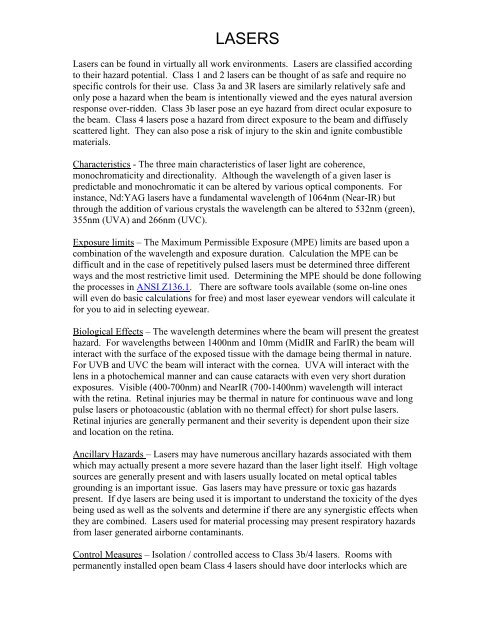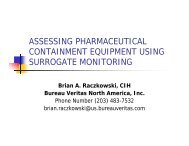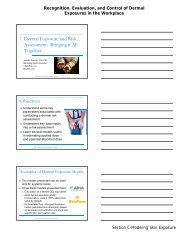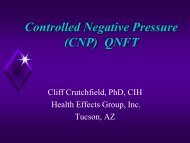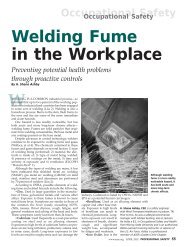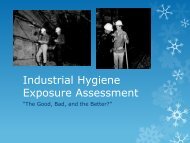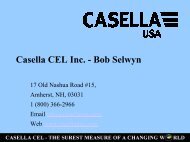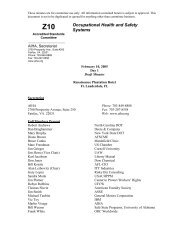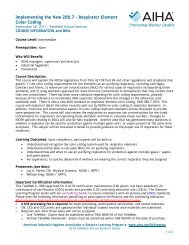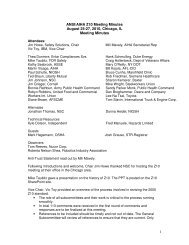Laser quick reference guide
Laser quick reference guide
Laser quick reference guide
You also want an ePaper? Increase the reach of your titles
YUMPU automatically turns print PDFs into web optimized ePapers that Google loves.
LASERS<br />
<strong>Laser</strong>s can be found in virtually all work environments. <strong>Laser</strong>s are classified according<br />
to their hazard potential. Class 1 and 2 lasers can be thought of as safe and require no<br />
specific controls for their use. Class 3a and 3R lasers are similarly relatively safe and<br />
only pose a hazard when the beam is intentionally viewed and the eyes natural aversion<br />
response over-ridden. Class 3b laser pose an eye hazard from direct ocular exposure to<br />
the beam. Class 4 lasers pose a hazard from direct exposure to the beam and diffusely<br />
scattered light. They can also pose a risk of injury to the skin and ignite combustible<br />
materials.<br />
Characteristics - The three main characteristics of laser light are coherence,<br />
monochromaticity and directionality. Although the wavelength of a given laser is<br />
predictable and monochromatic it can be altered by various optical components. For<br />
instance, Nd:YAG lasers have a fundamental wavelength of 1064nm (Near-IR) but<br />
through the addition of various crystals the wavelength can be altered to 532nm (green),<br />
355nm (UVA) and 266nm (UVC).<br />
Exposure limits – The Maximum Permissible Exposure (MPE) limits are based upon a<br />
combination of the wavelength and exposure duration. Calculation the MPE can be<br />
difficult and in the case of repetitively pulsed lasers must be determined three different<br />
ways and the most restrictive limit used. Determining the MPE should be done following<br />
the processes in ANSI Z136.1. There are software tools available (some on-line ones<br />
will even do basic calculations for free) and most laser eyewear vendors will calculate it<br />
for you to aid in selecting eyewear.<br />
Biological Effects – The wavelength determines where the beam will present the greatest<br />
hazard. For wavelengths between 1400nm and 10mm (MidIR and FarIR) the beam will<br />
interact with the surface of the exposed tissue with the damage being thermal in nature.<br />
For UVB and UVC the beam will interact with the cornea. UVA will interact with the<br />
lens in a photochemical manner and can cause cataracts with even very short duration<br />
exposures. Visible (400-700nm) and NearIR (700-1400nm) wavelength will interact<br />
with the retina. Retinal injuries may be thermal in nature for continuous wave and long<br />
pulse lasers or photoacoustic (ablation with no thermal effect) for short pulse lasers.<br />
Retinal injuries are generally permanent and their severity is dependent upon their size<br />
and location on the retina.<br />
Ancillary Hazards – <strong>Laser</strong>s may have numerous ancillary hazards associated with them<br />
which may actually present a more severe hazard than the laser light itself. High voltage<br />
sources are generally present and with lasers usually located on metal optical tables<br />
grounding is an important issue. Gas lasers may have pressure or toxic gas hazards<br />
present. If dye lasers are being used it is important to understand the toxicity of the dyes<br />
being used as well as the solvents and determine if there are any synergistic effects when<br />
they are combined. <strong>Laser</strong>s used for material processing may present respiratory hazards<br />
from laser generated airborne contaminants.<br />
Control Measures – Isolation / controlled access to Class 3b/4 lasers. Rooms with<br />
permanently installed open beam Class 4 lasers should have door interlocks which are
LASERS<br />
capable of disabling the laser. Beams should be confined to the table and steps taken to<br />
minimize stray reflections. Beams should be enclosed whenever possible. If lasers are to<br />
be used outdoors additional consideration should be given for the potential to interfere<br />
with aviation.<br />
Personal Protective Equipment – <strong>Laser</strong> protective eyewear is rated using Optical Density<br />
(OD), a logarithmic scale of the amount of attenuation the filter provides for a specific<br />
wavelength or wavelength range. It is important to remember to that all modes of<br />
operation and possible wavelengths be considered when choosing the eyewear. <strong>Laser</strong><br />
users should ALWAYS wear properly rated laser eyewear when hazardous open beams<br />
are present.<br />
References and Additional Information<br />
American National Standards Institute Z136.1, Safe Use of <strong>Laser</strong>s. <strong>Laser</strong> Institute of<br />
America.<br />
American National Standards Institute Z136.6, Safe Use of <strong>Laser</strong>s Outdoors. <strong>Laser</strong><br />
Institute of America.<br />
Chapter 22, Nonionizing Radiation in The Occupational Environment: Its Evaluation,<br />
Control, and Management. Fairfax, VA: AIHA.<br />
CLSO’s Best Practices in <strong>Laser</strong> Safety. <strong>Laser</strong> Institute of America.<br />
Ken Barat, <strong>Laser</strong> Safety Management. CRC Taylor and Francis Group.<br />
Ken Barat, <strong>Laser</strong> Safety: Tools and Training. CRC Taylor and Francis Group.


